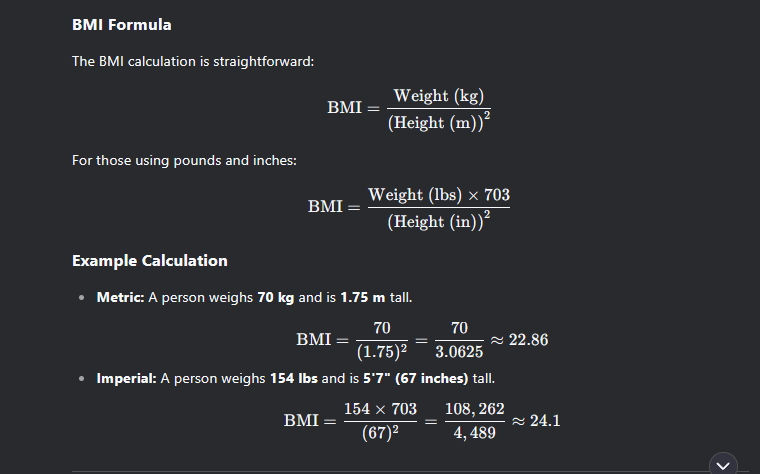BMI Calculator
Your BMI is
BMI is not a diagnostic tool. Consult a healthcare provider for assessment.
Introducing BMI.
Even though BMI is not a real measure of body fat, it is still used widely by physicians and fitness practitioners and even people interested in understanding what their weight might predict for their health status. We’ll explain in this detailed reference:
..BMI is what? And the computation of BMI?
..The various types of BMI and what they signify
..Disadvantages of BMI
..The link between BMI and health status
..The subsequent query-how is one to maintain a healthy state in BMI?

What Is BMI?
BMI slopes for Body Mass Index and is a number derived from the person's weight and height. The idea was coined back in the 1800s by the Belgian mathematician and would only much later on become a standard tool for screening health risks with respect to weight.


In case your training ends in October 2023.
Underweight is considered to mean:
Insufficient nutrient intake
Bad sickness defenses
Serious bone density deterioration due to osteoporosis
Infertile women
Possible causes:
Superfast metabolism
Anorexia, bulimia
Chronic illness
What to do:
Consult your doctor or dietitian
Consume calorie-dense foods
Weight training for muscle
- Normal Weight (BMI 18.5 - 24.9)
This range has the least odds in most lifestyle-related chronic diseases. Aside from that, BMI is not representative of muscle mass; hence, an athlete may carry high BMI without having excess subcutaneous fat .
Healthy BMI Maintenance:
Well-balanced diet (fruits, vegetables, lean proteins)
Keep active (150+minutes/week)
Avoid additional sugars and processed foods
- Overweight (BMI 25-29.9)
Being overweight increases your chances for:
Type 2 diabetes
Hypertensive
Heart disease
Possible Causes:
Inactive lifestyle
Empty caloric intake
Heredity
Actions:
Improve workout time
Lower refined carbs and drink sugary drinks
Watch portion sizes
- Obesity : BMI >or= 30
The link between obesity and any one of the following health diseases includes:
Cardiovascular diseases
Sleep apnoea
Some cancers (e.g., breast, colon)
Diseases of joints (e.g. osteoarthritis)
Help for treatment includes:
Monitoring medical treatment
Programmed diet-exercise
Behaviour therapy when required
Limitations of BMI
Despite a lot of benefits with BMI, it has certain disadvantages as well:
- It Does Not Directly Measure Body Fat
A muscular athlete, their BMI may very much be high with this person's percentage of body fat being very low.
In the same way, members of the older generation may, at one time, have a normal BMI but very high percentage in body fat (sarcopenic).
- It Does Not Account for Fat Distribution
Visceral fat (in organ) is bad for health while subcutaneous fat may be less detrimental.
The waist to hip ratio would serve better as a measure to indicate health risks.
- Ethnic Differences
Asians with low BMI will have more health risks than those high BMI.
Polynesians may have higher BMI due to muscle mass influence.
Other methods:
Waist Circumference (>35" for females, >40" for males indicates danger)
Body Fat Percentage (healthy range: females: 21-33%; males: 8-19%)
Improve Your BMI:
For Underweight People
✔ Foods have nutrition packed in calorie-dense (nuts, avocados, whole grains)
✔ Muscle strength building through strength training
✔ No skipping meals
For Overweight/Obese People
✔ Diet: More fiber, lean protein, and healthy fats
✔ Exercise: 150+ minutes of moderate activity weekly
✔ Sleep: 7-9 hours every night (people poor sleep tend to gain weight )
✔ Stress management: yoga, meditation (cortisol increases fat storage)
Conclusion
BMI is simply for screening, it is useful but not infallible. Other health indicators should supplement BMI for instance; waist circumference, diet, and activity levels.
Bottom Line:
✅ For the vast majority,
Стоимость монтажа видеонаблюдения https://vcctv.ru
Smart crypto trading https://terionbot.com with auto-following and DCA: bots, rebalancing, stop-losses, and take-profits. Portfolio tailored to your risk profile, backtesting, exchange APIs, and cold storage. Transparent analytics and notifications.
Практика ремонта https://stroimsami.online и стройки без воды: пошаговые инструкции, сметные калькуляторы, выбор материалов, схемы, чек-листы, контроль качества и приёмка работ. Реальные кейсы, фото «до/после», советы мастеров и типичные ошибки — экономьте время и бюджет.